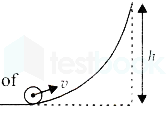1
Question
A small object of uniform density rolls up a curved surface with an initial velocity . It reaches up to a maximum height of with respect to the initial position. The object is a
A small object of uniform density rolls up a curved surface with an initial velocity . It reaches up to a maximum height of with respect to the initial position. The object is a
Open in App
Solution
Step1: Given data
- The initial velocity of the body is .
- The maximum height of the body on the curved surface is .
Diagram

Step2: Conservation of energy
- From the concept of conservation of energy, the sum of kinetic and potential energy is conserved in every point of motion. i.e.,
- The kinetic energy of a body moving with a velocity is and the kinetic energy due to rotation is , where, m is the mass of the body, I is the moment of inertia, and is the angular velocity of the body.
- The potential energy of a body at height h is , and g is the acceleration due to gravity.
Step4: Finding the moment of inertia
We know from the conservation of kinetic energy, that the sum of kinetic and potential energy is conserved at and .
So, .
Therefore, the moment of inertia of the body is , this is the moment of inertia of a disc about an axis passing through the center perpendicular to the plane. So, the object is disc.
Step1: Given data
- The initial velocity of the body is .
- The maximum height of the body on the curved surface is .
Diagram
Step2: Conservation of energy
- From the concept of conservation of energy, the sum of kinetic and potential energy is conserved in every point of motion. i.e.,
- The kinetic energy of a body moving with a velocity is and the kinetic energy due to rotation is , where, m is the mass of the body, I is the moment of inertia, and is the angular velocity of the body.
- The potential energy of a body at height h is , and g is the acceleration due to gravity.
Step4: Finding the moment of inertia
We know from the conservation of kinetic energy, that the sum of kinetic and potential energy is conserved at and .
So, .
Therefore, the moment of inertia of the body is , this is the moment of inertia of a disc about an axis passing through the center perpendicular to the plane. So, the object is disc.
Suggest Corrections
0
Join BYJU'S Learning Program
Join BYJU'S Learning Program





